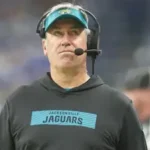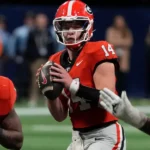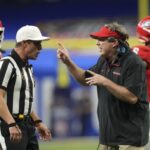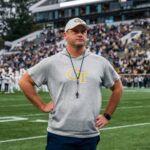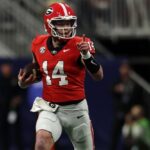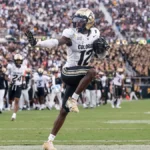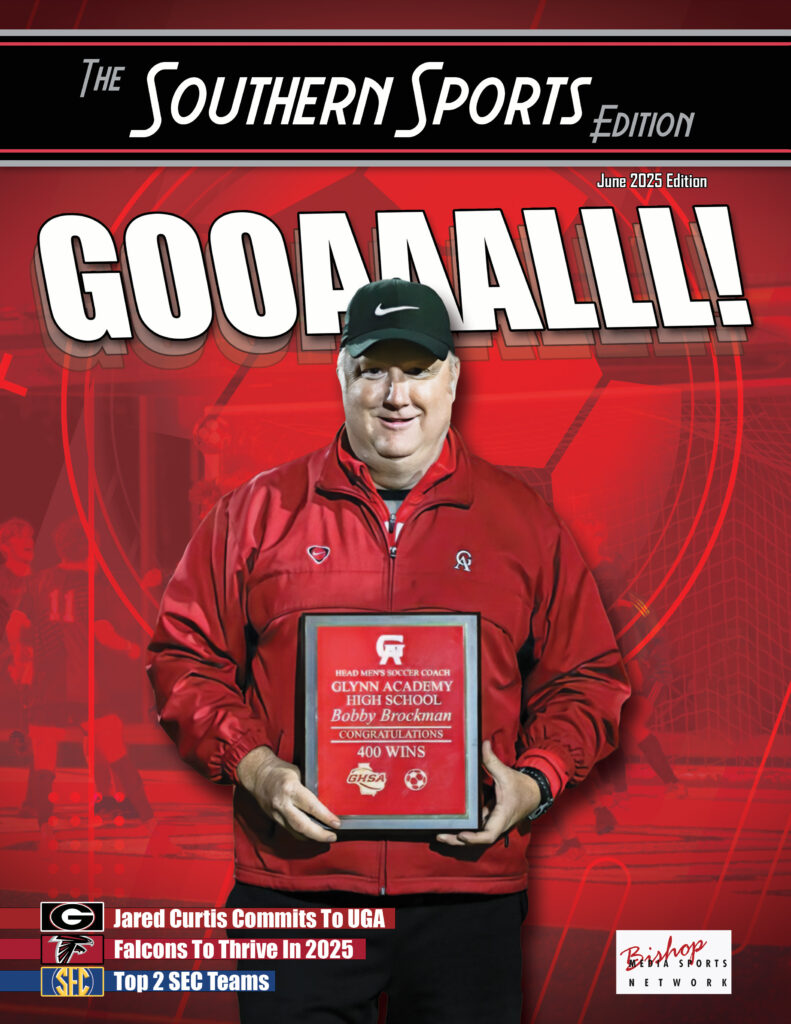The Fall Guy
 By: Kenneth Harrison
By: Kenneth Harrison
TheSouthernSportsEdition.com news services
The NFL regular season is over and coaches are starting to get fired as a result. Let’s talk about the Jacksonville Jaguars.
Jacksonville fired head coach Doug Pederson after going 4-13. They have lost 18 of their past 23 games. He did go 9-8 in his first two seasons before the bottom fell out in 2024. His record in Jacksonville is 22-29.
“I had the difficult task this morning of informing Doug Pederson of my intention to hire a new head coach to lead the Jacksonville Jaguars,” owner Shad Khan said in a statement.
“Doug is an accomplished football man who will undoubtedly enjoy another chapter in his impressive NFL career, and I will be rooting for Doug and his wife Jeannie when that occasion arrives. As much as Doug and I both wish his experience here in Jacksonville would have ended better, I have an obligation first and foremost to serve the best interests of our team and especially our fans, who faithfully support our team and are overdue to be rewarded. In that spirit, the time to summon new leadership is now.”
The Jags have retained General Manager Trent Baalke who is entering the final year of his contract. I do raise an eyebrow when only the head coach is fired from a losing team but the GM keeps his job. I view them as a package deal because the GM assembled the subpar roster that could not win games.
Khan will be looking for his sixth head coach since he purchased the team in November 2011 and assumed control in 2012.
Currently the other teams searching for a new head coach are the New York Jets, Chicago, New England and New Orleans. Out of these openings I think Jacksonville is the fourth best job with New Orleans being last.
This next year will be very important because we may finally have to look at quarterback Trevor Lawrence to see if he is a franchise QB. He was considered a generational talent when he was drafted #1 in the 2021 draft.
The Jags were 1-15 the previous year and they hired Urban Meyer for his first NFL head coaching position. They were 2-11 under Meyer before he was fired December 16, 2021. We don’t hold Lawrence’s rookie season against him.
His best season was his second year when he passed for 4,113 yards, 25 touchdowns and 8 interceptions. He signed a five-year, $275 million contract extension, including $142 million guaranteed on June 14, 2024. That tied Joe Burrow as the highest paid player in NFL history at the time of the signing.
Lawrence has dealt with injuries this season, which include a significant AC joint sprain and a concussion so he only played in ten games. With that being said, he did not perform like Burrow in the games he did play.
Rookie wide receiver Brian Thomas Jr. was great. He had 87 receptions, 1,282 yards and 10 TD’s.
The defense is ranked 31st in yards allowed per game (389.9) and last in passing yards allowed per game (257.4). On offense they were 25th in yards per game (305.8).
The top coaching candidate is Ben Johnson, the Detroit Lions offensive coordinator. They just secured the top seed in the NFC so they might make a deep playoff run.
Todd Monken, the Ravens offensive coordinator is also someone to look at.
Detroit’s defensive coordinator Aaron Glenn and Bills offensive coordinator Joe Brady are two more names to consider.
It will be interesting to see who the Jags hire and if they can quickly make them a contender.
New Tricks Needed?
 By: Robert Craft
By: Robert Craft
TheSouthernSportsEdition.com news services
The signs were always there. The Alabama game. The Ole Miss game. Even plenty of victories: Kentucky, Georgia Tech, and the SEC Championship Game.
It all left everyone, including those within the Georgia football program, questioning if this was a group that actually would keep the legacy going to another championship.
We got that answer in the College Football Playoff. It was definitive. Georgia was not the best team in the country this year and they deserved their fate.
Now it leads to the next mystery: Was this game, and rocky season a kick in the butt to the program? Was this season a message that Georgia’s not the elite it was two years ago?
Does leadership need to change goals and make moves to avoid slipping further?
Although Georgia was ultimately still the SEC champion, they lost in the College Football Playoff quarterfinals when they were down to their backup quarterback.
Kirby Smart said some curious things after the loss to Notre Dame. Let’s start with his post-mortem on the season, which he called “Easily the toughest of my tenure.” That may be a bit of recency bias.
The truth reared its ugly face at The Bulldogs, and it said: Get better as a football program. Let Kirby’s above words sit and remember people- it’s not a second-year coach trying to get his program to another level, but the ninth-year coach of a team that won two of the previous three national titles.
Maybe on some level Kirby Smart mirrors his mentor Nick Saban with the mentality of always trying to improve, even when on top. Or maybe this year’s team is a reflection that this program isn’t on top right now.
There’s no clear answer. You can argue that transfer rules and paying players have changed the game.
The Big Ten and Notre Dame having three of the four semifinalists feed into that argument. But the 2022 season wasn’t that long ago, right? It’s not like this was a crashing disappointment for the Dawgs: They’re 4-1 against teams that made the Playoffs, the only one they lost was in the Playoffs.
There was just something missing, and Smart’s job is to figure out what that was, and to what extent does this team need to change.
Now for some apparent good news: Gunner Stockton looks like a viable starter for 2025-26. His pocket presence needs to improve, but that should grow with experience.
The underrated gap between Carson Beck and Stockton, in a start of this magnitude, may have been game management and making checks at the line, which Stockton acknowledged.
But if it is Stockton, the coaches need to acquire help around them. QBs and Coaches need receivers who won’t drop the ball. Georgia was burned during this portal window by receivers unsure of the identity or throwing ability of Georgia’s quarterback next season.
Maybe Stockton’s play helps convince recruits and transfers.
Let’s be clear. There is risk in overstating what happened in this game. Georgia outgained the Irish and averaged more yards. They reached the red zone more often. It’s not like this was a domination. Georgia belonged on the same field, but Georgia should be the more mature program in the building; all evidence says they were.
Instead, Georgia committed the game’s only two turnovers, gave up a 98-yard kickoff return because of missed tackles, and coach Smart made risks that backfired.
Looking back, much of Georgia’s problem was being outplayed by Notre Dame, especially in the second half, when UGA approached the cusp of another epic comeback and failed: The defense made a big fourth-down stop, handing the offense the ball at midfield. A 10-point game, plenty of time left, momentum at Georgia’s back. But the Bulldogs couldn’t capitalize, with go-nowhere plays on third-and-3 and fourth-and-2.
That was yet another mystery about this team. Stockton, whose arm was the question coming in, passed for 234 yards and looked pretty good for a new starter. Georgia just couldn’t run the ball, despite Notre Dame being without its best defensive player, lineman Rylie Mills. The Dawgs also did not protect well, yielding four sacks.
The offense will remain the focus. The defense can reload by retaining the talented youngsters who understudied this year. This Bulldog team will still be young, and this year’s inconsistent play showed that Georgia doesn’t have a birthright to elite defenses in today’s College Football Landscape.
Georgia isn’t automatically elite just because of rings in 2021 and 2022. They aren’t automatically elite as long as Smart is coach, he is starting to lose.
Although optimism still reigned in a losing locker room, do they deserve optimism with this result?
What did this loss mean for the program? Was it a hit to the ego?
Bugs In The System
 By: Colin Lacy
By: Colin Lacy
TheSouthernSportsEdition.com news services
Just into the change of the calendar from 2024 to 2025, the first 12-team College Football Playoff has completed the first two rounds of the bracket.
Not that it surprises many folks, but the playoff format is already drawing grumblings from college football coaches, media, and fans alike.
Now that we’ve seen the first round, on-campus sites, and the quarterfinals round in four of the New Years Six Games, what have we learned and where should this go in the future?
To find out what we’ve learned, we must look back and see how we got here. The birth of the College Football Playoff began for the 2014 season and was formed as a four-team playoff for the National Championship until this season (2024) when the expansion to 12-teams took effect.
The expansion talks have been just that since the inception of the CFP but took some weight when an internal working group of ADs, Commissioners and former coaches/players was put into place in June of 2021.
That group was tasked with exploring what a format of an expanded playoff would look like in the future.
Fast forward a year and a half to December of 2022, the CFP Board of Managers unanimously agrees to implement the 12-team playoff beginning in the 2024 and 2025 seasons.
The part that severely went unnoticed in the expediency of the format change is that the working group was given a target date of beginning the format in the 2025 season.
SEC Commissioner Greg Sankey, who was in that working group, has publicly said that when the start date was moved up a full year, they knew there were going to be some bugs that needed to be worked out.
So, what are those bugs that have reared their ugly head so far through eight games in the CFP?
Going into the first round, outside of fans in Tuscaloosa and an SEC Head Coach that calls Oxford, Mississippi home, the majority of fans and media do not have many bones to pick with the 12-teams that are in the playoff, but questions have been raised about the selection process after the opening round.
Getting through the first round of on-campus hosted games felt like a chore with only one game ending within ten points. No matter the format, no matter the number of teams, and even with a flawless system there are always going to be conversations of “snubs” or “non-deserving” teams, so that’s not the elephant in the room.
The biggest issue we have with the current 12-team format is the seeding.
One of the cornerstones of this format was the emphasis on Conference Champions that would have the five highest rated conference champions in the final CFP rankings would automatically earn a spot in the field, and the four highest would earn a top four seed.
This year that plays out as the Big 10 Champion Oregon receiving the #1 seed, SEC Champion Georgia earning the #2 Seed, the Mountain West Champ Boise State as the #3 seed as the group of five representative, and Big 12 Winner Arizona State rounding out the group with first round byes as the #4 seed. The ACC champion Clemson was the 5th highest ranked conference champ and rounded out the field as the #12 seed.
The big rub has been the seeding of the conference champions with Boise State and Arizona State, while being deserving of being in the field due to winning their conference, a first round bye (which turns out didn’t fair so well for any of the four that earned it this year) shouldn’t have been in the cards for the Broncos or Sun Devils.
Discussions have already started at the top (SEC Commissioner Greg Sankey seems to always have that kind of pull) in order to not only change the seeding but also begin developing a system to re-seed after each round.
I suspect that even possibly as early as next year, we see the five highest ranked conference champions receive a slot in the 12-team playoff but are not guaranteed a top 4 seed and first round bye.
After this first cycle of the playoff that runs with the contract that runs out after the 2025 season playoffs, do not be surprised to see re-seeding come into play after each round similar to the NFL playoffs. This would put the highest remaining seed after each round facing the lowest remaining seed and so on.
At the end of the day, this process was rushed to get it online and while it is turned into a couple enticing games and fantastic environments for the first ever on-campus playoff games, there are still changes to be made to get it where it needs to be.
My biggest concern in the process is the impatience of folks forcing the hand to expand to 16 or beyond before the kinks are fully worked out with the 12-team format. Only time will tell.
Playoffs!
 By: Michael Spiers
By: Michael Spiers
TheSouthernSportsEdition.com news services
With college football bowl season in full swing, and the college football playoffs going on, it’s understandable that current focus is squarely on the collegiate gridiron.
But with just one week left in the 2024-25 NFL regular season, the pro league is offering its share of excitement.
There are still plenty spots and seeding up in the air in both the AFC and NFC playoff races. While some teams have locked in their spots, Week 18 is shaping up to be a high-stakes showdown for division titles, seeding, and those last few playoff berths. Here’s how things look after Week 17 officially ended following Detroit’s win on Monday night.
NFC Playoff Picture: The NFC race is heating up, especially in the North and South divisions.
The Detroit Lions are back on top after a wild 40-34 win over the 49ers. They’ll face the Minnesota Vikings in Week 18, a winner-takes-all battle for the NFC North crown and the conference’s No. 1 seed. Both teams are 14-2, but Detroit has the edge because of their Week 7 victory over Minnesota. In that game, Jahmyr Gibbs went off, racking up 160 total yards and a touchdown.
It’s simple: if the Lions win or tie, they clinch the division and the top seed. If the Vikings win, they take over the North. Either way, this primetime matchup is going to be must-watch football.
Down South, the Buccaneers are clinging to a one-game lead over the Falcons.
Tampa Bay just needs a win or a tie against my hometown New Orleans Saints in Week 18 to lock up the division.
The Falcons, though, have a tougher road. They need to beat the Panthers and hope the Saints upset the Bucs.
Meanwhile, the Eagles are cruising into the playoffs with the No. 2 seed locked up. The Rams, Commanders, and Packers round out the current NFC playoff teams.
AFC Playoff Picture: Over in the AFC, things are a little clearer, but there’s still plenty of drama.
The Chiefs have been dominant all season, clinching the No. 1 seed, so they’ll probably rest their starters in Week 18.
The Bills have locked in the No. 2 spot after crushing the Jets 40-14.
But the AFC North is still up for grabs. The Ravens and Steelers both have a shot at the division title and the No. 3 seed.
The Ravens will face the Browns, while the Steelers take on the Bengals. Both teams are already in the playoffs, but Week 18 will decide who comes out on top.
The Texans secured the AFC South a couple of weeks ago, and the Chargers clinched their spot last week with a win over the Patriots.
That leaves one wild card spot up for grabs, and the Broncos are sitting in the driver’s seat. They’re 9-7 and control their destiny, but the Dolphins and Bengals (both 8-8) are right behind them.
For Miami to sneak in, they need a win and a Broncos loss.
The Bengals need even more help, with both the Broncos and Dolphins needing to lose on top of their own win. On a side note: wouldn’t it be fun to watch former LSU great Joe Burrow, or Joe Shiesty as they call him in the ‘League’, take a 9-8 Bengals team that started the season at 0-3 all the way to a Lombardi Trophy?!
Week 18 Games to Watch: Here’s what’s on tap for the final week of the regular season:
NFC North Showdown: Lions vs. Vikings – The division and top seed are on the line. Winner takes all.
NFC South Fight: Buccaneers vs. Saints and Falcons vs. Panthers – Can Tampa Bay hold off Atlanta’s late push?
AFC North Battle: Ravens vs. Browns and Steelers vs. Bengals – The division title is still anyone’s game.
Wild Card Chase: Broncos, Dolphins, and Bengals – Denver controls the last spot, but Miami and Cincinnati aren’t out of it yet.
With so much on the line, Week 18 is going to be an absolute thriller. Whether it’s division titles or wild-card spots, every game has something riding on it.
Get ready for some fireworks as the regular season comes to an epic close!
Atlanta Buzz
 By: Kenneth Harrison
By: Kenneth Harrison
TheSouthernSportsEdition.com news services
The football season is over for Georgia Tech. For the second year in a row the Yellow Jackets finished 7-6. They lost the Birmingham Bowl last week to Vanderbilt, 35-27. The game was not as close as the score indicates.
They had seven players enter the transfer portal prior to the bowl game. That included their leading receiver, Eric Singleton Jr. and backup quarterback Zach Pyron.
“I think we made a tremendous amount of improvement throughout the course of the year. Excited where this team will continue to go,” Key said Friday after in the Birmingham Bowl at Protective Stadium. “You learn lessons through every experience in your life. A football team learns and grows through experiences.”
“Where this team is today compared to where this team was a year ago, I’m extremely proud of where they are, and I’m extremely excited about where we’re going moving forward.”
The record is the same as last year but I do agree, Tech has improved. In order to get to the next level they have to capitalize on opportunities and win big games. They had a 27-13 lead against #7 Georgia with less than 5 minutes remaining in the fourth quarter. They lost that game 44-42 in the eighth overtime. That was their seventh consecutive loss to UGA.
They did beat #4 Miami 28-23 at home in November so that was a good win.
Midway through October Tech was 5-2. They beat North Carolina but starting quarterback Haynes King was injured and he missed the next two games. They lost those games to #12 Notre Dame and Virginia Tech. Key called a team meeting after the Va. Tech game, which was October 26.
“We knew we needed at that point in a time, a strong voice in front of ‘em. Something had to be said. They had some adversity hit, they had some adversity hit for two weeks in a row,” Key said Thursday in Birmingham. “Really from that point forward you’ve seen a driven team. You’ve seen a team that’s playing for each other, a team that’s playing together, a team that truly buys into the no-scoreboard, play-the-next-play, faceless-opponent (mentality). Because they could have gone one of two ways that night, they really could have.”
We can begin to look to the 2025 season and they have added some players in the transfer portal. They currently have the No. 31 overall portal class in the country and No. 5 class in the conference.
That looks good on paper but we did see how that worked out for Florida State this season. Out of those fifteen players I will highlight some of them. They are adding WR Debron Gatling (South Carolina), OL Andrew Rosinski (North Carolina), TE J.T. Byrne (Cal), TE Harry Lodge (Wake Forest), DT Matthew Alexander (UCF) and LB Melvin Jordan (Oregon State).
The UCF transfer Matthew Alexander (6’3, 295 lbs) played in 39 games over the last three seasons for the Knights. He had 34 tackles in 2024. I think he might have the biggest impact in this portal class.
They will start the 2025 season August 30 at Colorado. The Buffaloes were 9-4 this season but they will lose Heisman Trophy winner Travis Hunter and starting quarterback Shedeur Sanders.
They play two games in September, both at home against Gardner-Webb and Temple.
These are games they can win but we will see how that plays out.
Gunner?
 By: Robert Craft
By: Robert Craft
TheSouthernSportsEdition.com news services
How well Gunner Stockton will perform is still unclear.
As the world finds out about him off the field, Stockton’s a Georgia folk hero, his bona fide attributes are being filled in: his small-town roots, how he got his name, the fact he drives a 1984 Ford pickup. Stockton keeps four or five cows back home in Rabun County, which has become a running joke with some of his Georgia teammates.
There is no known correlation between bovine ownership and quarterback ability, and in less than a week, Georgia faces off against Notre Dame in the College Football Playoff quarterfinals.
Here are a few football-centric takeaways from Saturday, the day before Georgia leaves for New Orleans. After offensive coordinator Mike Bobo and four of his players met with members of the media.
Georgia guard Tate Ratledge forgot something at the team facility one night this week, and when he went back to get it at 10 p.m., he saw Stockton still there, watching film.
That wasn’t that unusual, according to Delp, who said Stockton watched film for four to five hours after practices in the regular season, not knowing if he would even play as the No. 2 quarterback.
Bobo said he could tell Stockton “took to heart” that he needed to prepare each week like a starter. That helped him seamlessly replace Carson Beck in the second half of the SEC Championship Game by leading a touchdown drive right away.
Stockton possessed a game plan focused on Beck’s pocket-passing skills and integrated into UGA’s high-performing offense seamlessly.
The extra time to adjust and prepare should be a big help for the offense. Before Georgia knew they would play Notre Dame, Georgia’s “back to basics” approach during the first week of practice kept Stockton in more situational drills: two-minute, third-down and red zone.
It helped Stockton lead the offense, rather than serving as the understudy or scout-team veteran.
“Now I can tell he has full control of this huddle,” Ratledge said.
That said, the spark was already there when Stockton came in during the SEC Championship Game. The past few weeks of practice seemed to have cemented it.
“Just seeing the way he’s carried himself and done everything the right way in his prior years leading up to this moment, Gunner’s just a guy you want to block for,” Ratledge said.
“He’s just a great guy, plays with a lot of emotion, brings everybody with him, and now he has the whole team behind him, ready to roll.”
The offense hasn’t had a sterling year: Georgia ranks 30th in scoring and 42nd in yards per play. But four of its games have been against defenses ranked in the top 10 nationally, with two others in the top 20.
This is Bobo’s second year back as the coordinator. When he met the media this time in 2023, it was after a better statistical year, but the team didn’t have a chance at a championship. This time, Bobo still has a chance to set the narrative.
Georgia has two new tailback injuries: Roderick Robinson and Branson Robinson are both expected to miss the rest of the Playoff with unspecified injuries sustained during practice.
That ends injury-riddled seasons for both players and removes the team’s most physical runners.
It hasn’t been a great rushing season anyway, as Bobo acknowledged. Georgia is only 11th in the SEC in rushing yards per attempt and 15th in total rushing yards per game.
Georgia was in the top three the previous three seasons and was once known as Tailback U., including during Bobo’s first stint as offensive coordinator.
The offensive line is pretty much in full health now. Etienne is, too, and with Nate Frazier, Georgia has two dynamic options out of the backfield, while Cash Jones is a veteran blocker and pass catcher. With Stockton at quarterback, a better running game is needed against Notre Dame.
Play Defense and run the ball are keys to Georgia’s victory.
Georgia 23 Notre Dame 13.
Splashless
 By: Colin Lacy
By: Colin Lacy
TheSouthernSportsEdition.com news services
After what most Braves fans see as a 2024 Braves season that didn’t meet expectations, Alex Anthopolous was expected to make a splash this offseason to bolster the roster, but up until this point in late December, there has barely been a ripple, let alone a splash.
Most of the news involving the Braves coming across your ticker has been now former Bravos now donning a new uniform going forward.
The biggest subtraction from the Atlanta club is one that most suspected would not be back in the 404 after not landing on an extension prior to the 2024 season, but came to fruition in mid-December when Max Fried signed an eight-year contract with the Yankees.
Other departures include Travis d’Arnaud team option not exercised and promptly signing a two year deal with the Angels.
There have been some pens to paper to add to the Braves clubhouse, but most would fly under the radar for the casual Braves fan.
The most recent coming on December 20th with the Braves trading for RHP Davis Daniel with the Angles and sending minor league lefty hurler Mitch Farris to Anaheim.
Daniel was born in Atlanta and was a seventh-round selection out of Auburn. The former Tiger made his major league debut in 2023 with three appearances out of the Angels bullpen and put up a 2.19 ERA in the short debut season.
With experience in both the back end of the Angels rotation last year and out of the bullpen, Daniel gives the Braves options on how he is used and what the best path looks like for the partnership.
The only other addition to note (if you want to call it that) is signing outfielder Bryan De La Cruz to a one-year non-guaranteed deal.
The past few years haven’t worked out for De La Cruz. In 2024, De La Cruz started the season with the Marlins and fell victim to the Miami Fire Sale in late July when he was traded to Pittsburgh for a pair of prospects.
After 44 games with the Pirates, De La Cruz was non-tendered by the club after just a .200 average and three homers.
There are a couple of bright spots in this somewhat head-scratching signing for the Braves. While Atlanta fans can hope for another rejuvenating season that the Braves development staff have done in the past, the biggest plus to this signing is options.
De La Cruz is a young player at 27 years old and still has options to be used, so if he doesn’t make the team out of spring, he can be sent to Gwinnett as depth.
Because of not exercising d’Arnaud’s $8 million option and re-working the contracts of Renaldo Lopez and Aaron Bummer to a lower dollar amount than anticipated, the Braves have some money to play with to go after that “splash” that has been hoped for since September.
Anthopolous said early in the off-season that he wouldn’t be deterred by the higher penalties (higher taxes with competitive balance tax thresholds) in order to go out and sign someone that could really help the club, but now the question is what’s the priority?
You can argue if the priority should be a bat in the outfield or help in the rotation or a key bullpen arm.
To me, the lineup should be mark number one. As hot and cold as the offense was last season, they seemed to be missing a solid bat in the middle of the order to be consistent all season long.
You find that, in a way, it takes the stress off the pitching staff both on the rotation and the pen. Now… just have to find it.
Moving On
 By: Michael Spiers
By: Michael Spiers
TheSouthernSportsEdition.com news services
The Atlanta Falcons made waves in early 2024 by signing veteran quarterback Kirk Cousins to a big four-year, $180 million deal.
But less than a year later, the team is already moving on. In a move that surprised many, Atlanta drafted Michael Penix Jr. with the eighth overall pick in the NFL Draft.
At the time, Penix was seen as a long-term project, but with their playoff hopes slipping away, the Falcons decided to speed up his development.
This bold decision not only shifts the team’s short-term game plan but also puts a spotlight on Cousins’ uncertain future.
Cousins started the season strong, but things went downhill fast over the last month. During a 1-4 stretch, he threw just one touchdown compared to nine interceptions and was sacked 11 times.
Now sitting at 7-7, Atlanta is still technically in the NFC South playoff race, but Cousins’ struggles left them little choice but to bench him.
The move shows the team no longer trusts him to lead—not just for the rest of this season, but likely beyond.
Financially, Cousins’ contract comes with challenges, but Atlanta has some options. He’s guaranteed $27.5 million in 2025, with another $10 million guaranteed in 2026 if he’s still on the roster.
The Falcons could release him after the season as a post-June 1 cut, which would result in a $40 million dead-cap hit. While that’s a hefty number, it would clear future obligations in 2025 and 2026.
Trading him is another option, though it’s trickier. They could save up to $27.5 million with a post-June 1 trade, but his no-trade clause and declining performance make this scenario harder to pull off.
From the beginning, it was clear Cousins might not be a long-term solution. Falcons GM Terry Fontenot turned heads by drafting Penix just weeks after signing Cousins, signaling the team was already planning for the future.
Fontenot defended the move, calling it a smart way to secure a franchise quarterback down the line. But the decision to bench Cousins so soon shows they never fully believed he could be the answer.
Unless Penix falters or the team makes a deep playoff run, it seems likely Cousins’ time in Atlanta is done.
His recent struggles, combined with the team’s pivot to Penix, highlight both his decline and the Falcons’ urgency to develop their rookie QB.
While Cousins could technically stay on as an expensive backup in 2025, that seems unlikely given the team’s commitment to moving forward with Penix.
Starting Penix now is a gamble, but one the Falcons felt they had to take. With the playoffs still within reach, they’re hoping the rookie can give their offense a spark.
Head coach Raheem Morris acknowledged the stakes, saying they didn’t expect to have such a high draft pick again, making Penix a key part of their future plans.
As for Cousins, his next move is up in the air. Teams like the Jets, Raiders, Titans, or even the 49ers and Rams could potentially be interested, especially with coaches like Kyle Shanahan or Sean McVay who have ties to Cousins from earlier in his career. Still, his declining play and no-trade clause complicate things.
At the end of the day, the Falcons’ switch from Cousins to Penix reflects a bigger strategy. They’re looking ahead to the future while trying to salvage what they can this season.
Whether this gamble pays off right away or takes time, it’s clear Atlanta is entering a new chapter at quarterback.
Strike The Pose
 By: Robert Craft
By: Robert Craft
TheSouthernSportsEdition.com news services
After winning the Heisman Trophy, Colorado’s Travis Hunter hugged his fiancée and then his mom.
When he got to Buffaloes’ coach Deion Sanders, the hug lasted a little longer.
He even went back in for another, putting his head on Sanders’ shoulder, and you could hear Hunter getting choked up.
Hunter thanked Coach Prime for changing his life, but the same can be said the other way around. Hunter is Sanders’ proof of concept.
Travis Hunter’s rise to stardom, fulfilling the promise of his five-star potential while playing full-time on both offense and defense, is Sanders’ most significant accomplishment as a college football coach. Hunter is the example Sanders can hold up to every other blue-chip recruit in the country.
More importantly, Hunter’s spectacular season should serve as an example to all those blue-chippers pondering where to go to school: Those coaches need you more than you need them. Don’t be afraid to chart your own path.
“I wanted to be different,” said Hunter, who also won the Biletnikoff Award as the nation’s best receiver and the Bednarik Award as the best defender. “So, you know me, being different makes me feel more comfortable than doing the norm.”
Coaches sell players on their ability to get guys to the NFL all the time. The numbers suggest the Alabamas, Georgias and Ohio States are better than most at developing NFL players.
The reality, though, is what really sets those programs apart is their ability to recruit more players with NFL potential.
Hunter, a Florida native, could have gone to any school in the country after playing high school ball in Georgia.
He was committed to Florida State, but at the last moment flipped to Jackson State, a historically Black university in the FCS.
It was truly a road not taken. In the modern era of recruiting rankings, where the best of the best are identified and sorted earlier and better than ever, no player with Hunter’s pedigree had ever chosen to play in Division I’s second tier instead of the top.
For Sanders, it was the ultimate recruiting coup, swiping Hunter from his old school in Tallahassee.
Sanders sold something bigger than just getting Hunter to the league. During ESPN’s Heisman show, Sanders said he encouraged Hunter to be “unapologetically” himself.
Hunter’s mom, Ferrante Edmonds, called her son Travis a little goofy. He wears onesies. He said he never really listened to music until his fiancé opened his ears to Lil Wayne (who showed up on Saturday to congratulate Hunter).
Hunter’s favorite thing besides football is fishing. He said he spent his Friday night in New York watching fishing videos to chill out.
How many coaches would have given Hunter the opportunity to play both ways to the extent of Sanders, who probably could have done the same when he played for Bobby Bowden at Florida State, did with Hunter?
Hunter, along with Sanders’ son and star quarterback, Shedeur, will play their last games for No. 23 Colorado on Dec. 28 in the Alamo Bowl against No. 17 BYU.
Sanders has been adamant about his intent to remain Colorado’s head coach when his sons (he includes Hunter with Shedeur and defensive back Shilo) move on.
Hunter is unicorn of a football player, the legacy he leaves behind hopefully encourages more players to take the road less traveled.
Growing Wings
 By: Kenneth Harrison
By: Kenneth Harrison
TheSouthernSportsEdition.com news services
We are still early in the NBA season but I want to take a look at my hometown team, the Atlanta Hawks.
I’m normally critical of this franchise because they are never championship contenders.
Atlanta desperately needs to pair All-Star point guard Trae Young with another star player. Young has been with the franchise since he was drafted in 2018 and the Hawks still have not figured out how to do that.
They drafted Michigan shooting guard Kobe Bufkin with the 15th pick in the 2023 draft. He played poorly and was assigned to the G League to play for the College Park Skyhawks. He also dealt with injuries so he has not been able to make a contribution to the team.
Last season they were 36-46 and did not make the playoffs. The Hawks did get the top pick in the 2024 NBA Draft and they selected small forward Zaccharie Risacher (France).
So far he averages 10.9 points per game and 23.7 minutes per game. I understand he’s a rookie but more is expected from a No. 1 pick.
He’s shooting 27% from three, which is one of the reasons he does not play major minutes. He did score 33 points against the Knicks in early November so he has shown flashes of his talent.
De’Andre Hunter is in his sixth year and he comes off the bench for Risacher. He’s actually the better player because he averages 19.3 ppg and makes 45% of his threes.
He’s led the team in scoring in six games. I know the organization wants to show their top pick they have confidence in him but he should be coming off the bench.
Jalen Johnson is also listed as a small forward and he’s having a breakout season. He was picked in the first round of the 2021 draft from Duke.
Johnson is averaging 19.6 ppg, 10.1 rpg and 5.5 apg. He has led the team in scoring in eight games so far with 29 as the season high twice.
Shooting guard Dyson Daniel (Australia) was picked 8th in the 2022 draft by Charlotte. He was traded to the Hawks in July for Dejounte Murray. Daniels is averaging 13.4 ppg but he has led the team in scoring twice.
The team is currently 14-13. They have young talent and it shows because they are very inconsistent.
They started the season with two wins then they lost their next four. They lost three in a row in late November, then won six in a row.
The NBA has the pointless in-season tournament, the Emirates NBA Cup. The Hawks beat the New York Knicks in the quarterfinals, 108-100. They lost to Milwaukee in the semifinals, 110-102 over the weekend.
“Just as a team, we got a lot of room to grow,” Hawks forward Jalen Johnson said. “I’m proud of everybody. We defeated a lot of odds, coming in and making it all the way to Vegas. So, there’s nothing to hang our heads about. We just gotta keep moving in the right direction.”
“Our growth is not going to be just linear,” Hawks coach Quin Snyder said. “We’re going to have those moments, and every time we have, like tonight, you know, what can we take from it? And I think that’s really true for Zacch and Dyson and JJ. These moments, because they’re getting an opportunity at a young age to be in them there’s a lot of opportunity.”
Atlanta has potential to be a good team and I think they can make the playoffs as a fifth or sixth seed.
